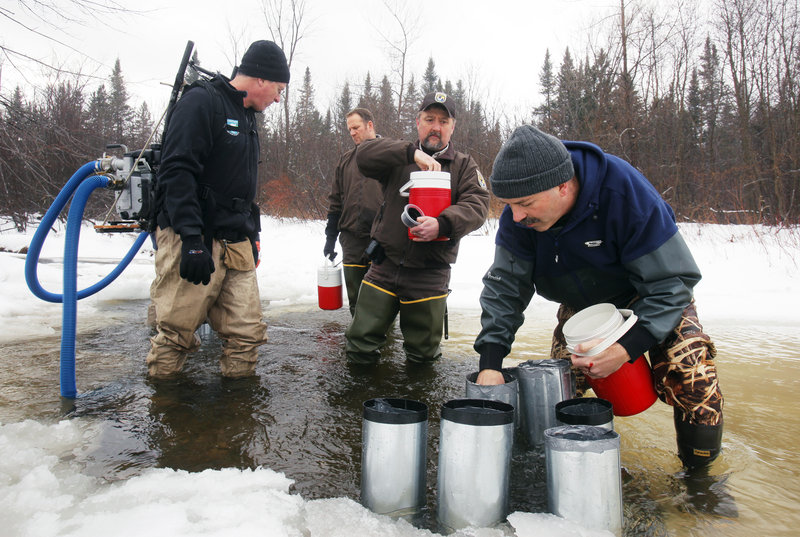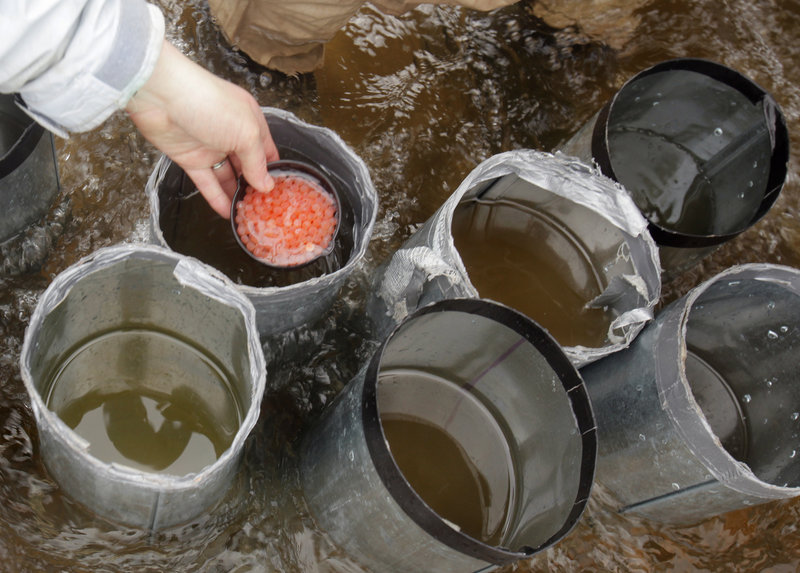AVON – With a makeshift air gun fashioned with duct tape and a gas engine on a home-rigged backpack, the biologists with the Department of Marine Resources laughed as they blasted holes for hatchery eggs into a rocky tributary of the Sandy. But their work could be a part of a long-sought Atlantic salmon solution.
Biologist Paul Christman quietly has planted Atlantic salmon eggs in Maine rivers for three years, but in another two years his project could move to the forefront of the national Atlantic salmon recovery effort. Already the project makes Maine a leader in North America in salmon recovery, said Joan Trial, Maine’s senior salmon biologist.
“Salmon restoration has been going on quite a while. Paul is coming up with a way to produce more (salmon) spending more time in a natural environment as opposed to a hatchery. There is some strong evidence that these fish may be more successful surviving out at sea. The more time they spend in their natural habitat, the more imprinted they will be to it. This could be a piece to the puzzle, and a very intriguing piece,” said Trial.
Salmon were first listed as threatened by the U.S. Fish and Wildlife Service in 2000 in a small portion of Maine. Then in 2009, the list was expanded and the salmon’s status elevated to endangered.
Trial said the first few years Maine stocked fry in its rivers, there were encouraging results. But that was 10 years ago, and while the removal of dams since then has led to sea-run fish like alewives and herring running up Maine rivers once again, the salmon’s return has been slow.
In addition, those salmon returning are not all wild. And to be taken off the endangered species list, Maine must have wild Atlantic salmon returning to rivers here.
Currently the service is working on a recovery plan that maps out what is needed to delist the salmon. That plan will go to public comment later this year, said Antonio Bentivoglio, the service’s Atlantic salmon recovery coordinator in Maine.
But it will take at least 10 years for the necessary criteria to be met for the salmon to be delisted to threatened and then endangered status, Bentivoglio said.
“For delisting, we have to minimize the hatchery influence, so the hatchery won’t be stocking millions of par and smolts. Then we’ll have much great confidence that they are wild fish,” Bentivoglio said. “Once we get to threatened status, then we’ll have a plan in place to slowly decrease the number of hatchery fish that go out. We want to slowly reduce it, so we can assess the impact, and hopefully wild fish will increase.”
ON THE LIST
First the Atlantic salmon need to show returns of at least 6,000 in its historic ranges: Merrymeeting Bay, the Penobscot River and the Downeast rivers.
In 2010 in the Downeast rivers, just 164 Atlantic salmon returned; in the Penobscot River there were only 1,316; and 14 in Merrymeeting Bay (the Androscoggin and Kennebec rivers), Bentivoglio said.
So the recovery effort has a long way to go.
Whether Christman’s egg planting project can get DMR there is unknown. But there is a lot of hope in the offices at USFW and the Maine fishery agency because the salmon that result from the eggs he plants are considered “more wild” than the fry stocked from hatchery raised eggs.
The salmon that emerge from the eggs Christman plants are considered wild enough to be counted when the service considers whether to downgrade salmon from endangered to threatened, Bentivoglio said.
But the salmon’s international plight is complicated. Scientists still do not know why their marine survival is low, in some cases as low as 50 percent.
“(Christman’s eggs) should be more viable in their natural environment than the hatchery produced smolts. There should be more going out to sea. But we’re not sure what’s going on with marine survival and why marine survival has been so low. Something is going on out in the ocean that the United States, Iceland, Canada and Greenland are trying to figure out, too,” said Trial in Maine’s Bureau of Sea Run Fisheries and Habitat.
OUT TO SEA
The first egg planting done by Christman was in 2009. But in the Atlantic salmon’s life cycle, those fish won’t return to their native rivers, where the salmon emerge from the eggs until 2014. At that point, everyone at DMR will be watching to see if they do. If all goes well, lots of salmon should return.
In 2009, Christman planted 130,000 in the Sandy River; in 2010, he increased the number to 450,000; and again to 860,000 last year. This year, 1 million Atlantic salmon eggs will be planted in salmon habitat in Maine.
His work has shown success with survival rates. The emergence rate from eggs is upward of 40 to 50 percent in some places, he said, which is as good as egg planting projects anywhere.
But the telltale sign will be if the salmon return in 2014. Christman thinks they will return from the sea and run up Maine rivers to where he has planted eggs.
“The idea is that they are more in tune with the river than hatchery fish. Their performance should be better, and their survival better. And from what we’re seeing, yes, they are behaving much better,” Christman said.
Staff Writer Deirdre Fleming can be contacted at 791-6452 or at:
dfleming@pressherald.com
Twitter: Flemingpph
Send questions/comments to the editors.





Success. Please wait for the page to reload. If the page does not reload within 5 seconds, please refresh the page.
Enter your email and password to access comments.
Hi, to comment on stories you must . This profile is in addition to your subscription and website login.
Already have a commenting profile? .
Invalid username/password.
Please check your email to confirm and complete your registration.
Only subscribers are eligible to post comments. Please subscribe or login first for digital access. Here’s why.
Use the form below to reset your password. When you've submitted your account email, we will send an email with a reset code.